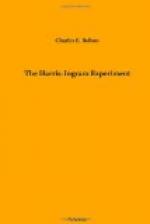Prominent citizens now hurried to the mayor’s office, where the chief executive was found in conference with some of the labor leaders. The mayor was told that unless he acted promptly in restoring peace and protecting property, a citizens’ committee of safety would be organized, that he would be placed under arrest, and the mob driven back. At once the mayor sent one hundred policemen in patrol wagons in pursuit of the rioters. The latter had already battered down the great doors of the screw-works, and hundreds of employees, men, women, and children, were driven out of the factory. The president of the company was beaten into insensibility. Adjacent nail works were ordered to close and all employees were driven into the streets. Finally, near night, the strikers were subdued by platoons of police and forced to return to their homes.
The mayor issued his riot act, which was printed in all the evening papers and read as follows:
TO THE CITIZENS OF HARRISVILLE AND THE PUBLIC GENERALLY.
In the name of the people of the State of Ohio, I, David A. Duty, Mayor of the City of Harrisville, do hereby require all persons within the limits of the City to refrain from unnecessary assemblies in the streets, squares, or in public places of the City during its present disturbed condition, and until quiet is restored, and I hereby give notice that the police have been ordered, and the militia requested to disperse any unlawful assemblies. I exhort all persons to assist in the observance of this request.
David A. Duty.
Mayor.
The mayor telegraphed to the governor for troops. The governor responded promptly, and ordered the First Brigade to be in readiness, and to report at 5 A.M. next morning in Harrisville, with rifles, cannon, Gatling and Hotchkiss guns and ammunition. Orderlies went flying through the city with summons that must be obeyed. The signal corps flashed their green and red lights from the tower to distant armories. Ambulance corps hastened their preparation, packing saws, knives, lint, and bandages.
Imperative orders from general to colonels, to majors, to captains, to corporals tracked the militia men to their homes, and to their places of amusement. By midnight every military organization in Harrisville was under arms. The general with his staff was at his headquarters and ready for action.
Before sunset Colonel Harris had his steel mills enclosed by a high fortress-fence; many agents were dispatched to other cities to advertise for, and contract with, skilled labor for his mills. On his way home, he called again on the mayor, also at brigade headquarters, and satisfied himself that his property would be protected. In forty-eight hours five hundred new workmen had arrived, and in squads of from twenty-five to fifty they were coming in on every train.
Colonel Harris, experienced in strikes, knew just what to do. A great warehouse in the board enclosure was converted into barracks and supplied with beds, and kitchens, and an old army quartermaster was placed in charge. The new men on arrival were taken under escort of the soldiers to the barracks, and were rapidly set to work under loyal foremen.




